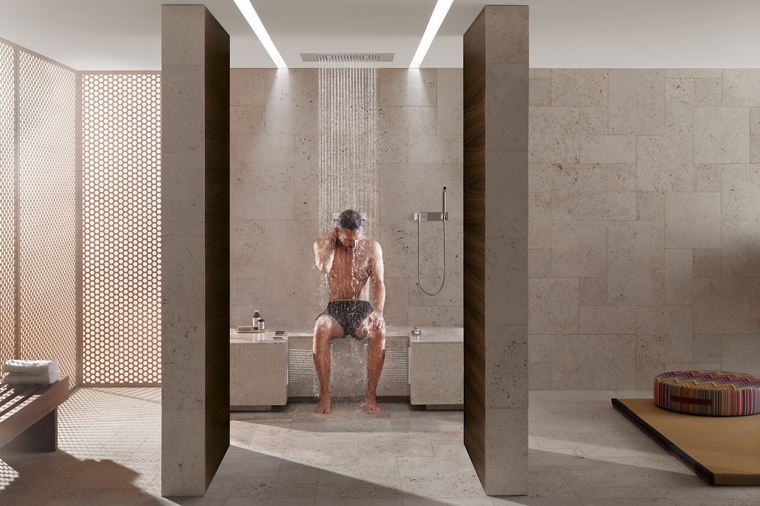A smart networked home where all sanitary facilities can be controlled by smartphone or computer is no longer a fantasy. Public facilities such as hotels or office buildings have long had smart drinking water systems. The manufacturers belonging to the Blue Responsibility initiative know automatic water management ensures best drinking water quality, while providing more convenience and safety.
“When it comes to digitalisation in private and public sanitary facilities, it's not technology that's first and foremost, but what can be achieved with it,” says Michael Beese from Dornbracht. “Digital technology can be used to control water and handle drinking water efficiently and safely.” With innovative system solutions, operational sequences can be performed and monitored to preset parameters. “A networked building with a smart control system sustainably contributes to drinking water hygiene. Furthermore, safety is promoted, as the smallest of deviations can be registered and rectified immediately,” reports Wolfgang Burchard, spokesperson for the Blue Responsibility initiative. Internet-enabled systems are especially convenient as they can be controlled via smartphone or computer regardless of the user's location.
Clean water brings change
If water is left to stagnate for a long time, germs and legionella start to develop which in turn have considerable adverse effects on drinking water hygiene. “Legionella primarily multiply in a temperature range of 30 – 45 °C. To make sure the temperature can be kept at a minimum of 60 °C, the water must not stagnate,” Walther Tillner from Oventrop explains. The sanitary ware provider's automation station therefore ensures that a sufficiently high circulation temperature is maintained to counteract the growth of legionella.
In public buildings, in particular, e.g. schools or event halls, sanitary facilities are affected by fluctuations in frequency and duration of use, which can cause a build-up of bacteria. Hygiene flushing helps to safeguard the water quality in the building facilities long-term. This is also a specific flushing procedure taken by Kemper: “When planning a building, the assumption is that there will be a static operating state. But actually, user behaviour is very dynamic,” explains Stefan Pohl from Kemper. “We control the change in water by means of time, temperature and volume parameters, which counteract the build-up of bacteria.” Operation is easy and can be carried out with the web interface via smartphone, tablet or laptop. Upon request, malfunctions can also be reported directly by e-mail.
Geberit also offers a simple solution for controlled and automatic water exchange. “With our monitoring and control technology adjustments can be made to flush volumes and intervals conveniently and anywhere using an app. We offer installers and operators of drinking water installations four flushing programs for individual operation,” explains Volker Röttger from Geberit. An integrated readout function records data with information about flushing procedures, start of flushing, flushing volumes, and temperature and sends this to the smartphone or tablet.
Whether for the entire range of the drinking water system, or a stand-alone solution for the sink, WC, or urinal – with the aid of internet-supported flushing functions property owners will save money, as building services engineers can carry out monitoring, diagnostic and configuration tasks from their offices. When it comes to drinking water hygiene, the McDreams Hotel in Mönchengladbach isn't taking any chances. The hotel owner has recently invested in automatic WC hygiene flushing systems from Mepa. Thanks to the circulation circuits, only a third of all cisterns in the 82 hotel bathrooms had to be equipped.
Comprehensive water management for smart control
With a Schell water management system all fittings in public sanitary facilities are linked to each other by radio or cable. Up to 64 sink, shower, WC or urinal valves can be connected to the water management server, the heart of the system. “The Internet of Things is definitely the full-on trend at the moment,” says Jens Gebers from Schell, knowlingly. “Systems with remote monitoring, control and maintenance support sustainability because less mobility is required.” Thanks to the diagrams, analysis and logging, the user can update the parameters of the hygiene programs and valves at any time. Another concept for the smart control of valves is “peak load optimisation” from Franke Aquarotter. In buildings with peak times of use, such as during breaks in stadiums and schools, the system registers an increasing number of users and reduces the flush volume, for example, in the urinal. When the frequency decreases again, a thorough general flush takes place.
Smart early detection of leaks
A smart water management system not only provides for top drinking water hygiene, but also for safety: In Germany, 3,000 water-damage incidents occur on a daily basis, which incur high costs. A smart house installation, e.g. Syr, prevents leaking lines, overflowing bath tubs, and pipe ruptures: “Our leak protection systems monitor actual water consumption every second, and compare the measured values with a preset nominal value. If the latter is exceeded, the entire pipeline system is blocked off immediately,” explains Marcel Wirtz from Syr. “In the process, we consider the four fields of leak protection, water treatment, hygiene monitoring, and heating monitoring.” Information such as remaining capacities or salt range can be requested via the free app or web browser.
Blue Responsibility stands for sustainable drinking water hygiene
“Our innovative sanitary technology allows us to meet the requirements of the building operators who are attaching more and more value to the straightforward operation of water management systems,” explains Verena Töpfer-König from Franke Aquarotter. The members of Blue Responsibility use digital innovative products to ensure the sustainable use of the resource of water. “Drinking water hygiene can be optimised, in particular, thanks to smart water management systems,” says Wolfgang Burchard. Automated building management therefore creates more sustainability, economically as well as ecologically.
Further details regarding this topic can be obtained on the manufacturers' websites www.dornbracht.com, www.franke.com/watersystems, www.geberit.de, www.kemper-olpe.de, www.mepa.de, www.schell.eu, www.syr.de and www.oventrop.com.
